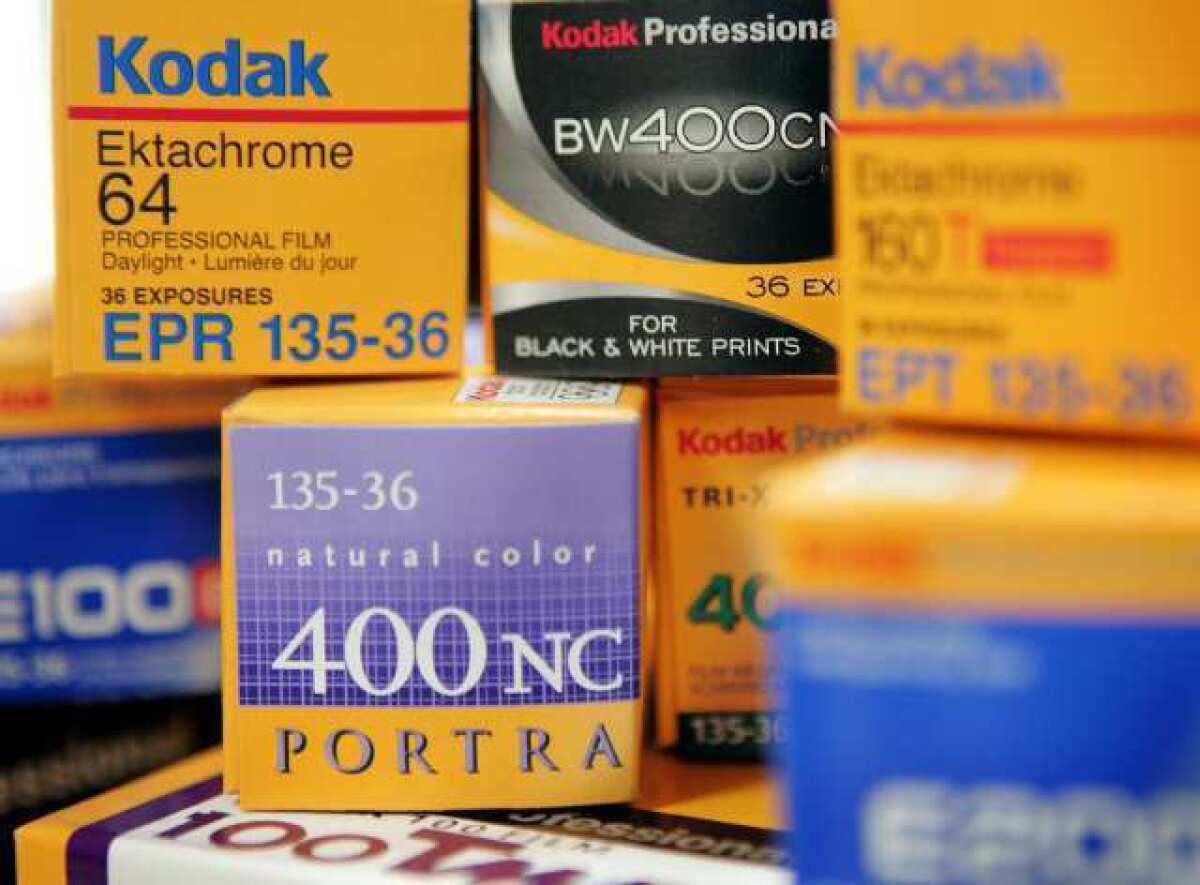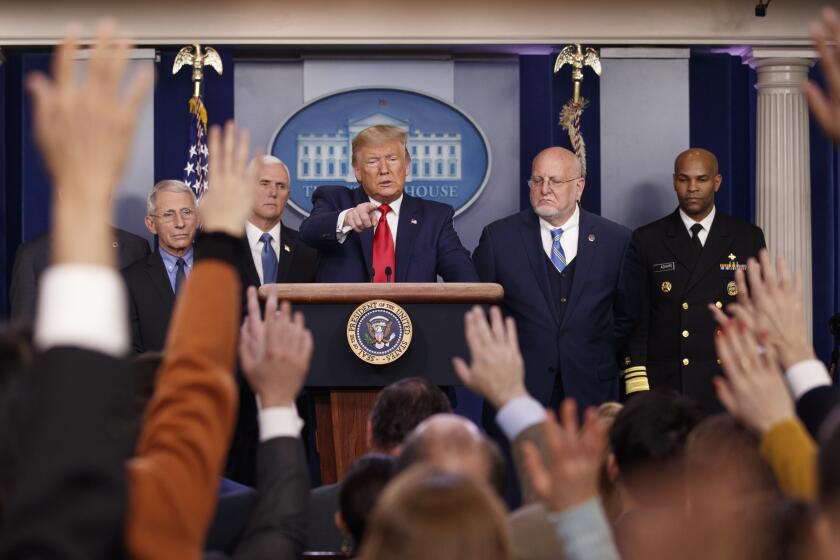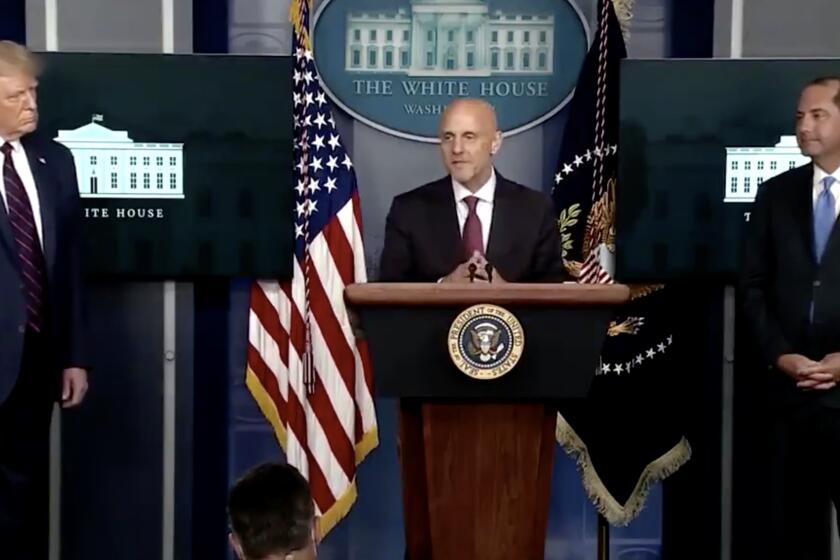Column: How a botched COVID ‘loan’ to Kodak made the company and government look like idiots

- Share via
Among the milestones of the federal government’s half-baked responses to the COVID-19 crisis, the short, unhappy life of its $765-million loan to Kodak stands out.
It may be remembered that President Trump, with great fanfare, announced the loan on July 28.
Trump said from the White House that the loan would help launch Kodak Pharmaceuticals and pay for Kodak’s entry into the business of producing “critical ingredients” for COVID-19 treatments.
A momentous step toward achieving American pharmaceutical independence — a very, very big, big step.
— President Trump, describing a deal with Kodak that never actually happened
He called it “one of the most important deals in the history of U.S. pharmaceutical industries.”
Well, no. It turned out that the U.S. hadn’t made the loan at all, but only signed a “letter of interest” indicating that it might do so in the future.
Meanwhile, Kodak’s shares soared into the stratosphere. The day before the announcement, the stock was priced at $2.62. The day after the announcement, it reached $60, before falling back to $33.20 at the close. On Thursday, it closed at $10.70.
Meanwhile, top Kodak executives had received large stock option grants, large well-connected investors sold shares into the surge, and one board member donated 3 million shares to a charity he had founded, valuing the gift at the $33.20 price, or roughly $100 million.
With the episode turning into an embarrassment as regulators and members of Congress began examining whether insider trading had gone on, the government agency behind the transaction — the U.S. International Development Finance Corp.—put the whole arrangement on hold on Aug. 7. It’s still on hold.
Kodak’s long fade to black
The outside law firm Kodak’s board hired to investigate the affair, Akin Gump, has just issued its report, which the company has made public.
Perhaps unsurprisingly, the report absolves Kodak executives and the big investors of violating insider trading laws, although it recommends that some internal processes be tightened so that nothing like this happens again.
More interestingly, the report takes us step by step through the timeline of the would-be deal. While Kodak and its executives don’t come off looking terrifically well, government officials, including Trump’s trade advisor Peter Navarro, come off looking worse.
Let’s take a stroll through this thicket. Wear your long pants and carry insect repellent.
Kodak, once a powerhouse in the photography and specialty chemicals businesses, was a spavined shadow of its former self by 2019. Although it was a public company, in real terms it was as good as private, as a small circle of investors owned more than 60% of its shares.
Once the COVID-19 pandemic took hold, Executive Chairman and CEO Jim Continenza pressed executives to “brainstorm for opportunities ... in the pandemic response,” the report says.
The company moved into manufacturing isopropyl alcohol for hand sanitizer and polyester film for face shields. It also cold-called government officials, fishing for a grant to allow it to move into pharmaceutical manufacturing.
In April, Kodak ended up in touch with Navarro and Chris Abbott, a White House policy aide. Contacts with Navarro increased after May 14, when Trump issued an executive order authorizing the Development Finance Corp. to make loans to companies in the COVID-19 treatment supply chain.
Kodak initially asked for a $27-million grant. Navarro urged the company to “think bigger” and asked for a “well fleshed out” proposal by the end of May, according to the report. Kodak responded with a request for up to $575 million, which Navarro called “too big,” Kodak employees told Akin Gump.
The U.S. has the worst record on COVID-19 among rich countries, by far. A new analysis spells it out.
By June, the plan had morphed into a loan request. At that point, Navarro had apparently backed away from the process — he canceled a scheduled June 4 call with Kodak, and they had no further contact.
At Kodak’s headquarters in Rochester, N.Y., the feeling was that the whole deal was probably dead. But the company pushed ahead with its formal application, presumably in the expectation that lightning might strike.
The talks with the government had been relegated to a low-level government official who didn’t seem to be reading the company’s application submissions. It wasn’t even clear that a loan would be good for Kodak, as it would require that the company raise some money itself as an equity down-payment.
The government official, Alale Allal, then took a tour of Kodak’s manufacturing facilities on June 22. Suddenly and mysteriously, things suddenly got turbo-charged. The Development Finance Corp. said it wanted to issue a “letter of interest” supporting the loan — and wanted to announce it at a public signing ceremony on July 28.
Planning for the event, including preparation of all the written material, was “‘driven’ and ‘owned’ by the DFC,” Akin Gump reported.
The planning included issuance of a media advisory on July 27, an “exclusive” given to the Wall Street Journal for publication July 28, and a press release to be issued at the time of the ceremony at 4 p.m. July 28. Kodak’s contribution to the press release was a canned quote from Continenza and a description of Kodak’s business.
Then things went off the rails. A low-level Kodak PR person sent the advisory to local Rochester reporters, but unaccountably removed a warning that the information about the next day’s event was embargoed and replaced with the line “for immediate release.”
Local reporters immediately tweeted the advisory’s language that the upcoming announcement could “change the course of history for Rochester and the American people.” One TV reporter’s tweet added, “Wow, that’s quite a promise.”
Trump’s record of cozying up to anti-vaccine advocates dates back more than a decade.
The Wall Street Journal published its exclusive at 6 a.m. the next day. But it misleadingly reported that Kodak had “won a $765 million government loan,” not that the arrangement was merely a nonbinding “letter of interest” rather than a loan. The DFC issued its own press release a few hours earlier to correct the misimpression.
Kodak stock took off, rising as high as $11.80, and reaching the $60 level the next day. Inside Kodak and among investment experts, the reaction to the price action was “outright incredulity,” Akin Gump reported. Board member Jeffrey Engelberg told the investigators that he thought the market had “lost its mind” simply because the news touched on COVID-19.
As is his habit, Trump vastly overplayed the significance of this deal at the White House, calling it “a momentous step toward achieving American pharmaceutical independence — a very, very big, big step.”
Skepticism about Kodak’s ability to deliver on Trump’s assertion was widespread, however. As my colleague David Lazarus concluded after speaking with an expert, “tapping a company with little pharmaceutical experience as your backstop doesn’t make a lot of sense.”
It wasn’t long before the options grants and stock trading by Kodak insiders and investors became public. Continenza and board member Philippe Katz made sizable purchases in June, while talks with the government were ongoing, at about $2.22. But Akin Gump says they haven’t sold those shares and had received permission in advance from the company’s general counsel to make the purchases.
More curious was a 3-million share contribution by board member George Karfunkel to Congregation Chemdas Yisroel, a charity he founded, based on the $33.20 closing price on July 29. Karfunkel told the investigators that the charity hadn’t sold any of the shares as of Aug. 24, when they interviewed him.
But the investigators said they weren’t able to fully delve into the transfer because they didn’t have access to the charity’s records or to any of its officers or directors, other than Karfunkel.
They concluded that even if the gift didn’t violate insider trading law or company policy, “it was not advisable from a corporate governance perspective” since it raised the possibility of insider trading.
Trump attacks the Food and Drug Administration and undermines its science while its leadership stays silent.
Then there was the sale of more than 250,000 Kodak shares by Moses Marx, the father-in-law of board member Philippe Katz, on the day after the announcement.
Akin Gump says Katz had told Marx about the upcoming announcement on July 24, but by the time of the sale, the deal had become public so Marx may not have been trading on nonpublic information. Marx declined to speak with Akin Gump.
Another big investor, Southeastern Asset Management, a Memphis investment firm, sold 4 million Kodak shares the day of the announcement and another 30 million shares that it had received in a notes conversion, on Aug. 4.
Those sales took place after the announcement; the company said it had concluded that Kodak‘s price had gotten too high, and that the firm had no access to inside information.
Despite finding that Kodak and its executives appeared to have broken no laws, the investigators still found that the entire affair exposed weaknesses in the company’s legal oversight. Board members weren’t fully up to speed on the complexities of insider trading rules, in part because Kodak’s legal department is understaffed.
Kodak’s PR department also needs an upgrade, the report found. In Kodak’s heyday, its PR team was almost certainly world-class. That today a junior employee could release confidential information about a big announcement a day in advance of the event suggests that it’s no longer staffed by pros.
All this has been bad for Kodak. The botched announcement makes the company look like it’s run by amateurs. More seriously, a funding deal that might really have helped Kodak move into a new business segment is still on hold because of the bungling.
The White House deserves a hefty share of the blame, too. It pushed for an announcement of a deal that wasn’t ready for prime time, or even for the Saturday morning children’s hour. Trump can crow about taking a “momentous step” all he wants, but all he achieved this time around was a momentous fiasco.
More to Read
Inside the business of entertainment
The Wide Shot brings you news, analysis and insights on everything from streaming wars to production — and what it all means for the future.
You may occasionally receive promotional content from the Los Angeles Times.













